A) $75,000 and producer surplus is $27,000.
B) $63,000 and producer surplus is $12,000.
C) $75,000 and producer surplus is $12,000.
D) $63,000 and producer surplus is $27,000.
F) B) and C)
Correct Answer

verified
Correct Answer
verified
Multiple Choice
The rules established under GATT are enforced by the
A) governments of the nations that are involved in GATT.
B) North American Free Trade Association.
C) World Trade Organization.
D) European Union.
F) B) and C)
Correct Answer

verified
Correct Answer
verified
Multiple Choice
When a country abandons a no-trade policy,adopts a free-trade policy,and becomes an importer of a particular good,
A) producer surplus increases and total surplus increases in the market for that good.
B) producer surplus increases and total surplus decreases in the market for that good.
C) producer surplus decreases and total surplus increases in the market for that good.
D) producer surplus decreases and total surplus decreases in the market for that good.
F) None of the above
Correct Answer

verified
Correct Answer
verified
Multiple Choice
Figure 9-17 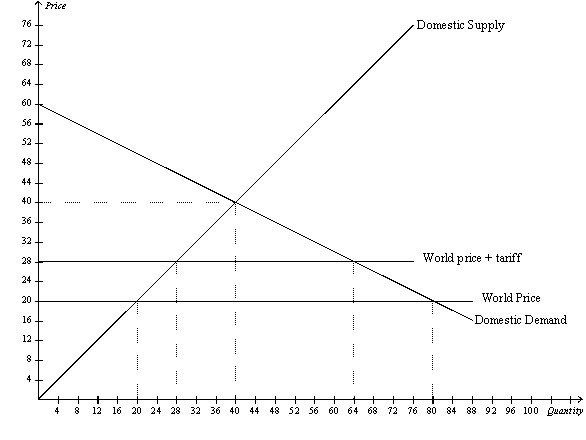 -Refer to Figure 9-17.Without trade,consumer surplus is
-Refer to Figure 9-17.Without trade,consumer surplus is
A) $400 and producer surplus is $200.
B) $400 and producer surplus is $800.
C) $1,600 and producer surplus is $200.
D) $1,600 and producer surplus is $800.
F) B) and C)
Correct Answer

verified
Correct Answer
verified
Multiple Choice
Figure 9-3.The domestic country is China. 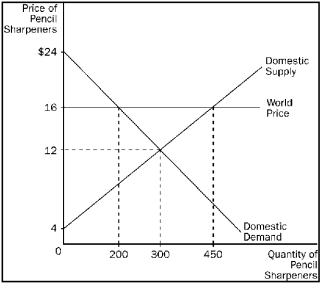 -Refer to Figure 9-3.The increase in total surplus in China when trade is allowed is
-Refer to Figure 9-3.The increase in total surplus in China when trade is allowed is
A) $400.
B) $500.
C) $600.
D) $750.
F) B) and D)
Correct Answer

verified
Correct Answer
verified
Multiple Choice
A common argument in favor of restricting international trade in good x is based on the premise that
A) international trade reduces total surplus in countries that export good x.
B) international trade reduces total surplus in countries that import good x.
C) international trade is desirable only when countries with different domestic supplies of natural resources play by different rules when trading with one another.
D) trade restrictions can be useful when one country bargains with its trading partners.
F) A) and B)
Correct Answer

verified
Correct Answer
verified
Multiple Choice
Figure 9-15 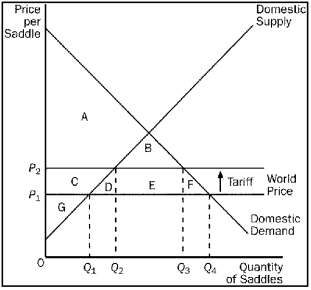 -Refer to Figure 9-15.A result of the tariff is that,relative to the free-trade situation,the quantity of saddles imported decreases by
-Refer to Figure 9-15.A result of the tariff is that,relative to the free-trade situation,the quantity of saddles imported decreases by
A) Q2 - Q1.
B) Q3 - Q2.
C) Q4 - Q3.
D) Q4 - Q3 + Q2 - Q1.
F) A) and D)
Correct Answer

verified
Correct Answer
verified
Multiple Choice
Figure 9-12 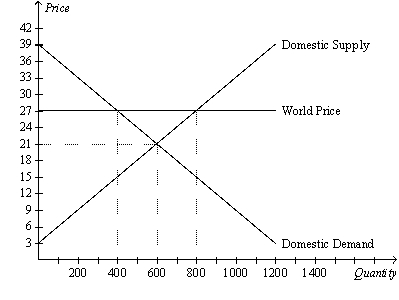 -Refer to Figure 9-12.Equilibrium price and equilibrium quantity without trade are
-Refer to Figure 9-12.Equilibrium price and equilibrium quantity without trade are
A) $27 and 400.
B) $27 and 800.
C) $21 and 400.
D) $21 and 600.
F) B) and C)
Correct Answer

verified
Correct Answer
verified
Multiple Choice
Suppose Guatemala has an absolute advantage over other countries in producing sugar,but other countries have a comparative advantage over Guatemala in producing sugar.If trade in sugar is allowed,Guatemala
A) will import sugar.
B) will export sugar.
C) will either export sugar or export sugar,but it is not clear from the given information.
D) would have nothing to gain either from exporting or importing sugar.
F) C) and D)
Correct Answer

verified
Correct Answer
verified
Multiple Choice
Figure 9-11 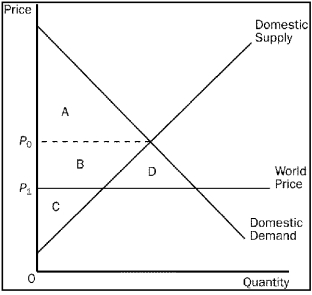 -Refer to Figure 9-11.Producer surplus plus consumer surplus in this market before trade is
-Refer to Figure 9-11.Producer surplus plus consumer surplus in this market before trade is
A) A + B.
B) A + B + C.
C) A + B + C + D.
D) B + C + D.
F) B) and C)
Correct Answer

verified
Correct Answer
verified
Multiple Choice
Figure 9-18.On the diagram below,Q represents the quantity of peaches and P represents the price of peaches.The domestic country is Isoland. 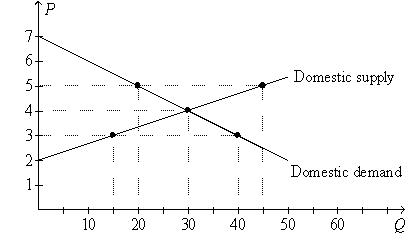 -Refer to Figure 9-18.If Isoland allows international trade and if the world price of peaches is $5,then
-Refer to Figure 9-18.If Isoland allows international trade and if the world price of peaches is $5,then
A) Isoland has a comparative advantage,relative to other countries,in producing peaches.
B) Isoland will import peaches.
C) consumer surplus with trade exceeds consumer surplus without trade.
D) All of the above are correct.
F) B) and C)
Correct Answer

verified
Correct Answer
verified
Multiple Choice
Figure 9-15  -Refer to Figure 9-15.Producer surplus with trade and without a tariff is
-Refer to Figure 9-15.Producer surplus with trade and without a tariff is
A) G.
B) C + G.
C) A + C + G.
D) A + B + C + G.
F) B) and C)
Correct Answer

verified
Correct Answer
verified
True/False
For Country A,the world price of soybeans exceeds the domestic equilibrium price of soybeans.As a result,international trade allows buyers of soybeans in Country A to experience greater consumer surplus than they otherwise would experience.
B) False
Correct Answer

verified
Correct Answer
verified
Multiple Choice
An import quota
A) is preferable to a tariff since an import quota does not create a deadweight loss.
B) is a tax on imported goods.
C) reduces the welfare of domestic consumers.
D) reduces the welfare of domestic producers.
F) A) and D)
Correct Answer

verified
Correct Answer
verified
Multiple Choice
Critics of free trade sometimes argue that allowing imports from foreign countries causes a reduction in the number of domestic jobs.An economist would argue that
A) foreign competition may cause unemployment in import-competing industries,but the effect is temporary because other industries,especially exporting industries,will be expanding.
B) foreign competition may cause unemployment in import-competing industries,but the increase in consumer surplus due to free trade is more valuable than the lost jobs.
C) the critics are correct,so countries must protect their industries with tariffs or quotas.
D) foreign competition may cause unemployment in import-competing industries,but the increase in the variety of goods consumers can choose from is more valuable than the lost jobs.
F) None of the above
Correct Answer

verified
Correct Answer
verified
Multiple Choice
Suppose a country abandons a no-trade policy in favor of a free-trade policy.If,as a result,the domestic price of beans increases to equal the world price of beans,then
A) that country becomes an exporter of beans.
B) that country has a comparative advantage in producing beans.
C) at the world price,the quantity of beans supplied in that country exceeds the quantity of beans demanded in that country.
D) All of the above are correct.
F) B) and C)
Correct Answer

verified
Correct Answer
verified
Multiple Choice
Figure 9-1
The following diagram shows the domestic demand and domestic supply for a market.In addition,assume that the world price in this market is $40 per unit. 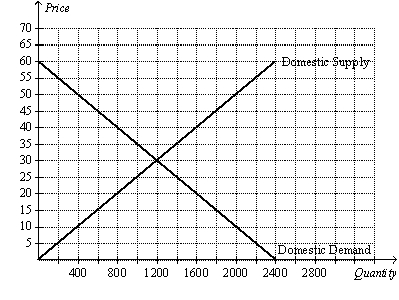 -Refer to Figure 9-1.With free trade,the domestic price and domestic quantity demanded are
-Refer to Figure 9-1.With free trade,the domestic price and domestic quantity demanded are
A) $30 and 1,200.
B) $40 and 800.
C) $30 and 800.
D) $40 and 1,600.
F) B) and C)
Correct Answer

verified
Correct Answer
verified
Multiple Choice
Figure 9-2 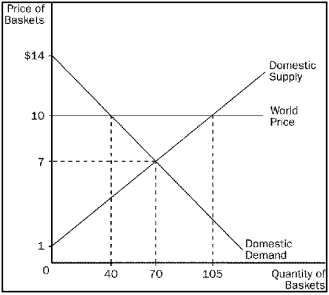 -Refer to Figure 9-2.As a result of trade,total surplus increases by
-Refer to Figure 9-2.As a result of trade,total surplus increases by
A) $80.
B) $97.50.
C) $162.50.
D) $495.50.
F) None of the above
Correct Answer

verified
Correct Answer
verified
True/False
Most economists view the United States as an ongoing experiment that raises serious doubts about the virtues of free trade.
B) False
Correct Answer

verified
Correct Answer
verified
Multiple Choice
A tariff on a product
A) is a direct quantitative restriction on the amount of a good that can be imported.
B) increases the domestic quantity supplied.
C) increases domestic consumer surplus.
D) All of the above are correct.
F) None of the above
Correct Answer

verified
Correct Answer
verified
Showing 21 - 40 of 441
Related Exams